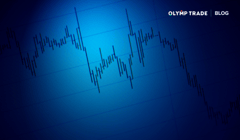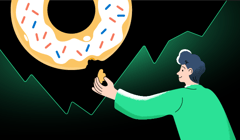
When and why does the stock market crash, and what is the best possible plan for a trader in such a scenario? This article aims at drawing some practical conclusions from the big market crashes in history.
Contents:
- Market Crashes are Inevitable
- Some of the Biggest Stock Market Crashes
- Stock Market Crash on the Chart
- Tips and Things to Understand About Stock Market Crashes
Interact with the underlined words and green dots to get additional details and explanations.
Additional context for the visuals.
Explanations and definitions of terms.
Market Crashes are Inevitable
Big market crashes can be caused by an imbalance in the process of development of the many parts that make up the market. Strictly speaking, the market can never be perfectly balanced. Just sometimes, it becomes imperfect enough to abruptly crash.
In a way, stock market crashes are partly caused by their very economic expansion. That’s why the big market crashes often follow the extreme growth periods.
IBM's stock grew from below $10 to over $100 during the ‘90s. Yet, in 2000-2002, the Dot-com crash cut around 50% of its value.
Amazon’s stock grew from $25 to almost $100 in 2006-2007. The 2008 stock market crash made it plunge 60% afterwards.
On top of the inherent economic disbalances that would cause the market crashes even in a perfect world, there are factors such as climate, viruses, and everything else that affects people but is partly or completely out of their control.
Such was the case of the 2020 market crash that followed the Covid-19 pandemic. However, while the virus as a force of nature might have sparked the market crash, it wasn’t the only and probably not the main reason. Rather, the ensuing social restrictions that caused business disruptions and the expectations of the same caused the panic that eventually erased up to 30% of the stock market value at the time.
Also, a market crash may be a result of a small accident such as a technical bug, electrical grid malfunction, or a squirrel that was going about its business. The latter is a true story that happened on the Nasdaq in December 1987. The market experienced a sudden crash because the animal gnawed on an electric cord that was powering the computer system of the stock exchange.
Some of the Biggest Stock Market Crashes

 1907 - The United Copper Company Case
1907 - The United Copper Company Case
This crash was largely a result of speculation around the shares of the bankrupt United Copper Company, fueled by mistrust towards banks. The stock market lost up to 20% of its value.
 1929 - Wall Street and the Great Depression in the US
1929 - Wall Street and the Great Depression in the US
The 1920’s were a period of an economic breakthrough in the US. As we have indicated above, periods of economic expansion are often followed by comparably large-scale market crashes. Such was the case of October 1929. Sparked by investors withdrawing their funds, the excessive retail debts became a burden too heavy for the market to carry on. Up to 85% of the stock market value was erased.
 1987 - “Black Monday”
1987 - “Black Monday”
The US-Iran confrontation and the oil crisis set the fundamental stage for this market crash. On top of that, new technologies were recently introduced to the stock markets back then. As often happens with new technologies, people were not familiar enough to use them safely. As a result, when the stock market crash started unfolding, precautions weren’t put in place in a timely manner to prevent larger losses. The S&P 500 and Dow Jones both lost up to 20%.
 2000 - Dot-Com Bubble
2000 - Dot-Com Bubble
The 1990's saw the spectacular rise of Internet technologies. Companies related to the IT industry such as Qualcomm grew hundreds of percent over that decade. The stock market expanded at a rate unseen before. At a certain moment, the buying spree stopped. People started to sell, the Federal Reserve put limits on monetary policy, and the stock market started spiraling down. The Nasdaq lost 75%.
 2008 - Subprime Mortgage Crisis
2008 - Subprime Mortgage Crisis
Years before the crisis, the real estate market was aggressively expanding. The stock market was following. When the retail borrowers started massively defaulting on their mortgages, the real estate market began shrinking, and the stock market crashed too.
Stock Market Crash on the Chart
The most recent big stock market crash was when the Covid virus arrived.

The S&P 500 dropped from above 3,300 to 2,200 over four weeks in February and March 2020. It lost approximately 30% of its value. That was indeed a big crash.
Yet, in June, the index was already at about the same level it dropped from a few months earlier. In September of the same year, it made a new high.
Therefore, even with the long-term effects of the virus and the measures related to it, the stock market recovered in a few months what was lost in the crash.
Tips and Things to Understand About Stock Market Crashes
While every stock market crash has its peculiarities, there may be a number of universally useful tips to follow in such scenarios.
Use Stop Loss on Every Trade
Stop Loss is there for a set of reasons. The possibility of a market crash is one of them. On the Olymp Trade platform, it is very easy to set it exactly where and when you make a trade. The image below provides an example.

The idea is simple. Setting a Stop Loss on every trade you do minimizes the possible hit your stock trades may take in a market crash.
Think Fundamentally and Observe
If you see the price of your trading instrument dramatically plunge, that’s not solid enough info to conclude that it’s a market crash. Examine fundamental factors relevant to your stock.
If the business of the stock you trade on is severely damaged, sales are plunging, infrastructure is malfunctioning, supply chains are broken, and it’s the outlook for the near future, then there might be a reason to worry. Otherwise, a crash you see in a chart might be just single day market noise that happened to be a bit more dramatic than usual.
Sometimes It’s Better to Step Away
Although there are ways to benefit even when the market is plunging, the risks and volatility are considerably higher during such periods. Unless you are an expert trader, you will likely risk more than you can gain if you try trading during a stock market crash. Therefore, if you see it all go down, consider just staying away for a while and re-grouping your portfolio to resume active trading when the storm has passed.
It’s Still Better Than Before
The global economy is developing, corporations are expanding, and the markets are becoming more complex. It may seem logical to conclude that if it all crashes, the damage may be much bigger than what the stock markets experienced before.
In practice, it may be the opposite. Decades of growth bring decades of experience. Financial institutions and corporations have more knowledge than before. That increases the range of tools they can apply to overcome a crisis ahead of time. Therefore, there is no reason to be afraid of the future more than before. There will be stock market crashes, and they will be overcome.
Olymp Trade is Always Happy to Help
Remember that Olymp Trade’s Help Center is a comprehensive knowledge base that provides guidance on the indicators and available trading instruments. In the meantime, Insights bring you the hottest market news and trading tips.
Check InsightsRisk warning: The contents of this article do not constitute investment advice, and you bear sole responsibility for your trading activity and/or trading results.
Nasdaq is a primary American stock market exchange based in New York.
Standard and Poor’s 500 is a primary stock market index that reflects the collective performance of the 500 largest US corporations.
Dow Jones is an important stock market index that tracks the collective performance of 30 selected US companies.
The US stock market index largely focused on IT and technology-related stocks.
It is a technical tool designed to help you minimize your risks on your trades.
Fundamental factors are essentially objective processes in the world that directly affect the business of a corporation.











